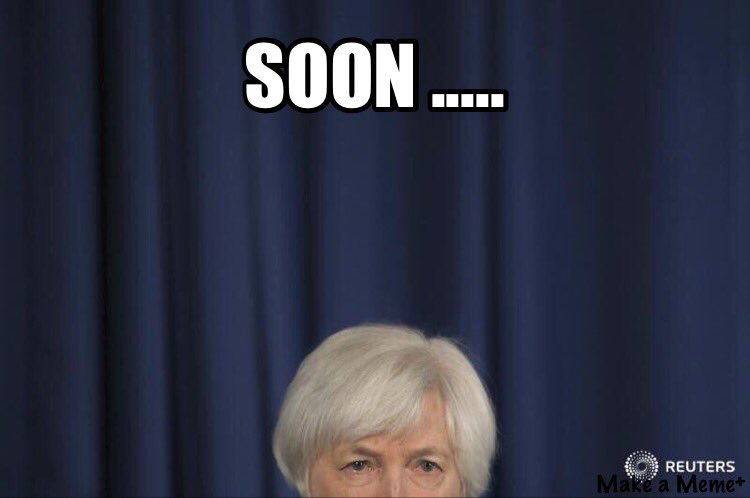
Global markets are showing they can't handle even a tiny bit of tightening by the Federal Reserve, observes David Haggith in this guest post, and other central banks are doubling down on rock-bottom interest rates. So after six years of "recovery" can we ever abandon endless easy money?
January was the winter of our discontented stock market. It was the worst January since 2008, when the Great Recession officially began. It was, in fact, the worst January in the history of the New York Stock Exchange. According to Citigroup, Inc., it was also the worst January ever for credit markets.
During many Fed tightenings, the stock market and overall economy improved for years afterward because the Fed stimulus had actually brought a temporary form of economic recovery. But rarely, if ever, has the mood turned dark so fast after the Fed officially announced that the recovery is sound and the life support can be removed.
So, even while I knew the global economic news was bleak, I didn’t expect the market bulls to snuff out their own ecstasy the day after the ball began. I can only imagine how much the permabulls wanted to go on air that next morning to revel in their we-told-you-sos about how the economy would do just fine after a Fed rate hike. Only they could not. They woke up to face reality.
Now that the Fed has decided to hold the Fed Funds target rate steady at their January meeting, everyone is nervously guessing which way the market will continue.
The Party in the Bull Pen Is Over
In December, Federal Reserve Chair Janet Yellen looked visibly happy when she was able to make the announcement of her lifetime — the claim that things looked optimistic enough for the Fed’s recovery that the Fed could finally end its economic aid. Never before has a Fed chairman looked less dour and more ready to crack open the champagne for the big Fed Christmas party.
Markets gleefully rewarded her with an immediate rise of 200 points in the Dow Jones Industrial Average during the remains of the day (December 16) after she delivered her glad yule tidings.
The market, however, decided to crash the party along Wall Street the next morning by dropping 253 points on December 17 — farther than it had risen during the celebration. The real gravity of those numbers was proven when the fall picked up speed for a 367-point plunge the next day, bringing the stock market down over 600 points before it closed at the end of last week.
And, so, the Fed’s rate hike made December the most volatile December for the Dow since the economic crisis of 2008. Moreover, since 1990, Decembers have been the least volatile month of the year. So, something is different this time. Something is very deeply and disturbingly different if you compare this seventy-degree day of winter solstice in Washington to any other.
It wasn’t your typical placid and merry December. Friday’s sell-off was the sharpest one-day plunge since September (up until January 7th’s 374-point plunge), and trading volume has been higher than usual in December as investors jockeyed to position themselves for the Fed’s anticipated rate rise. This is the feel of something big beginning to creep.
The sharp sell-off in stocks across all sectors of the Dow in the heaviest trading of the year came because of news that oil prices were still falling and fear over what this means for banks that are heavily involved in financing highly leveraged oil companies. For the past several years, such news would have caused the stock market to rise because it would mean another year of struggle in which the Fed would be hard at work trying to re-inflate the economy by giving free money to its friends in the financial sector.
All ten sectors of the S&P 500 also closed in negative territory the week of the Fed’s announcement. For the Dow, it was the third weekly decline in four weeks. Reality, in other words, hit the face like a glass of ice water the morning after the party. For the market bulls, it was off to work with a hangover.
The sobering fact that bank stocks were the first to decline was a surprise to many (including myself). Common wisdom throughout the market expected bank stocks to rise the fastest when the Fed raised rates because the rise in interest would actually improve bank profits since so many of their adjustable-rate loans and credit cards are pegged to interest rates that are strongly affected by the Fed’s target.
Banks will be collecting more in interest but they will be slow to start paying more interest on deposits, so were expected to benefit. Yet, financials went down because banks ensnared in a commodities massacre look edgy.
Even high-tech stocks, which have been supporting the narrowly traded market have been falling with the king of stocks — Apple — down 15 percent since the rate hike.
The global market had gone into a similar slide two weeks earlier when the European Central Bank did a little “quantitative wheezing” that didn’t satisfy the demands of its junkies. It was the same with Japan, where five rounds of QE have now failed to jack up the economy any longer than the QE lasted. QE is so unsuccessful that Japanese income and household spending are in decline again, even with the Bank of Japan embracing negative interest rates for the first time ever.
2016's phony crony Fed-led economy begins with a whimper. Will it end with a bang?
 David Haggith is editor of The Great Recession Blog, where a longer version of this post first appeared.
David Haggith is editor of The Great Recession Blog, where a longer version of this post first appeared.
Having foreseen the beginning of what is now called The Great Recession half a year before it hit, the economic collapse seemed to him the kind of thing anyone should have seen if his eyes were wide open.
A much-edited version of the original post appeared at the Mises Daily.
[Pic at head of post by MONETARY MAYHEM]
RELATED POSTS:
- “Thanks to relentless government and central-bank intervention, debt is growing at the same time that workers are becoming less entrepreneurial and less productive. That's not a good combination...”
Three Reasons to Be Worried About the US Economy – Yonathan Amselem, MISES DAILY - “The larger point is that the monthly jobs report has now become the essential vehicle for propagating a false recovery narrative that serves the interest of Wall Street and Washington alike.
“Month after month the artificially concocted and misleading headline jobs number is used to drive home a comforting meme. Namely, that the nightmare of the financial crisis and recession is fading into the rearview mirror; that the Fed and Washington have fixed the underlying ills, for instance, via Dodd-Frank; and that the soaring values of stocks and other financial assets since the March 2009 bottom are real, sustainable and deserved. …
“[And yet] food stamp participation rates are still the highest in history, and bear no resemblance to where these ratios stood during earlier intervals of so-called full employment. In a word, 4.9% unemployment can’t be true in a setting where the food stamp participation rate is nearly 15%.”
Why The Bulls Will Get Slaughtered – David Stockman, CONTRA CORNER - “I am writing to assure you this bitter January is a harbinger of global economic collapse. Let me make it repeatedly clear that this is far more than a stock market crash. We have entered the Epocalypse. We are standing in the dragon’s mouth as it dives into the abyss. Leaning against the dragon’s teeth, our central planners and gabby gurus look out at the spinning world around us and assure us they see no sign of anything that looks like a dragon; and, though the world appears to be spinning, it does not mean we are falling.”
Irrational Exuberance in Stock Market Knows No Bounds – David Haggith, THE GREAT RECESSION BLOG
1 comment:
Just 345 days until President Trump is along to fix the problems; no need to worry about it!
Post a Comment